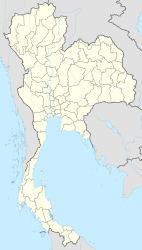Nong Bua Lamphu
|
บุรีรัมย์ Nong Bua Lamphu |
||
|---|---|---|
|
|
||
| Coordinates | 17 ° 12 ′ N , 102 ° 27 ′ E | |
| Basic data | ||
| Country | Thailand | |
| Nong Bua Lamphu | ||
| ISO 3166-2 | TH-39 | |
| Residents | 30,500 | |
|
Lak Mueang Shrine by Nong Bua Lamphu
|
||
Nong Bua Lamphu (in Thai : หนองบัวลำภู , pronunciation: nɔ̌ːŋ būa lām pʰūː , also Nakhon Khuen Khan Kab Kaew Bua Ban - "City with plenty of water and blooming lotus flowers", or Mueang Kamut Sai Buriram ) has been the capital since December 1, 1993 of the district ( Amphoe ) Mueang Nong Bua Lamphu and the province Nong Bua Lamphu in the northeast region of Thailand , the Isan .
geography
Nong Bua Lam Phu is located in the northeastern plateau, on the western edge of the Isan . The distance to the capital Bangkok is just over 600 kilometers.
economy
Rice cultivation is economically important .
history
The city was first mentioned about 900 years ago and was initially tributary to the kings of Laos . In 1574 the Thai conquered the kingdom of Lan Chang (Laos) under King Maha Thammaracha and his son, King Naresuan , and chose the area around Nong Bua Lamphu as a deployment area for the decisive advances. After the fall of Ayutthaya in 1767, the city was drawn into disputes within the Laotian leadership: two brothers (Phra Woa and Phra Tha) gathered their troops and fellow travelers and fled Laos to Nong Bua Lamphu. They built a city wall to protect themselves from persecution by the Laotians. The invading army could not prevent this from the partial destruction and depopulation of the city, but the wall remained. After various new attempts at settlement and renaming of the remaining remains, the final formation of the new city with the new name Nong Bua Lamphu took place under King Chulalongkorn ( Rama V ) in 1906, initially as a district ( Mueang ) of the Udon Thani province . In 1993, as part of the policy of decentralization, Nong Bua Lamphu was confirmed as the capital of the newly formed province of the same name.
Attractions
- Statue of King Naresuan the Great, erected in memory of the conquest of the Lan Xang Empire
- City wall from the 18th century
Personalities
- Isariya Marom (born 1995), football player
- Wittaya Thanawatcharasanti (born 1996), football player
Web links
- City map of Nong Bua Lamphu (names in English and Thai) [last accessed on November 14, 2013]

